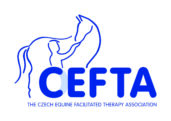Hippotherapy techniques (4) – Manual correction
 The therapist conducts manual correction based on knowledge of developmental kinesiology and his/her own clinical experience. Specifics of manual corrections of the chosen positions are described in our new text book – comprehensive methodology.
The therapist conducts manual correction based on knowledge of developmental kinesiology and his/her own clinical experience. Specifics of manual corrections of the chosen positions are described in our new text book – comprehensive methodology.
General principles of manual correction
- Manual correction is most commonly done for ball-and-socket joints and by influencing the positioning of the head according to the present condition of the client.
- When correcting the symmetry of the trunk and limbs, the therapist must be able to correct the symmetry of an independent position throughout the
 entire period of exercising in relation to the movement of the horse and during the deviations that come. He/she uses level contact most often on the pelvis, the lower rib area, the shoulder girdle and peripheral body parts.
entire period of exercising in relation to the movement of the horse and during the deviations that come. He/she uses level contact most often on the pelvis, the lower rib area, the shoulder girdle and peripheral body parts. - To maintain the overall quality of the position, the therapist must be able to continually assess whether,
in spite of all correction and intervention used, the response of the client is good and brings therapeutic value. Exercises must be discontinued if this is not the case (most often during decentration of the ball-and-socket joints, reclining of the head, asymmetry of the trunk, dissatisfaction or fatigue of the client). - For correction of differentiation, the therapist must be able to see the motion dynamic response of the client specifically in accepting the cross pattern with physiological response and not in a pathological response.
The therapist is able to combine individual corrections.
Komentáře
